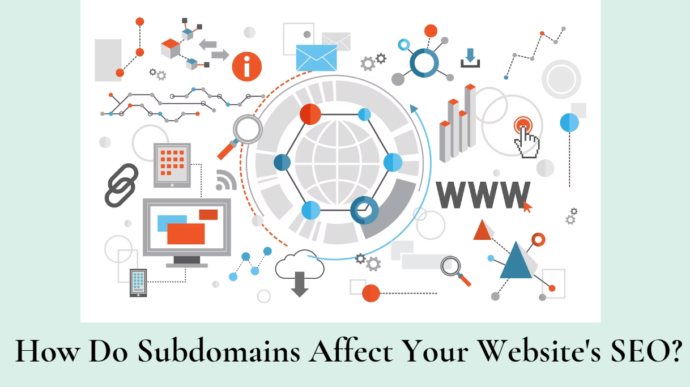- What is a subdomain?
- How to create a subdomain
- Subdomain vs Subdirectory structure
- When to use and not to use them on your website
- Benefits & downsides of subdomains for SEO
- Conclusion
How does subdomain SEO affect your site?
As you browse the internet, you might notice that the website address (URL) changes when you click on different sites.
Sometimes, the URL is straightforward like “www.examplesite.com.” Other times, you might see additional words before the site name, such as “www.app.examplesite.com.”
In this case, the “examplesite” word is called the main domain or root domain, the word “app” is called a subdomain, and it helps to distinguish one website from another.
In this guide, you’ll discover what subdomains are, how you can use them, and whether they have any effect on search engines SEO (search engine optimization).
What is a subdomain?
A subdomain is an extra part added to the root domain that helps in organizing and separating site structure.
When you use a subdomain, you can create distinct areas within your main site, like a blog or an eCommerce store, which are separate from the main sections.
Every URL consists of three main domain parts:
- Top-Level Domain or TLD: This is the extension found at the end of the URL, such as .com, .org, or .io.

2. Second-Level Domain or SLD: This is the catchy and unique part of the domain name. For example, in the domain name “trustindex.io,” the term “trustindex” represents the second-level domain. It is the element that helps identify the main site.

3. Subdomain: In this context, the subdomain refers to the part of the URL that appears before the main domain name “examplesite.” For instance, if you visit app.examplesite.com, the subdomain “app” directs you to a specific page on the website.
Websites often utilize subdomains to create distinct sections, enhancing organization and improving the overall user experience.
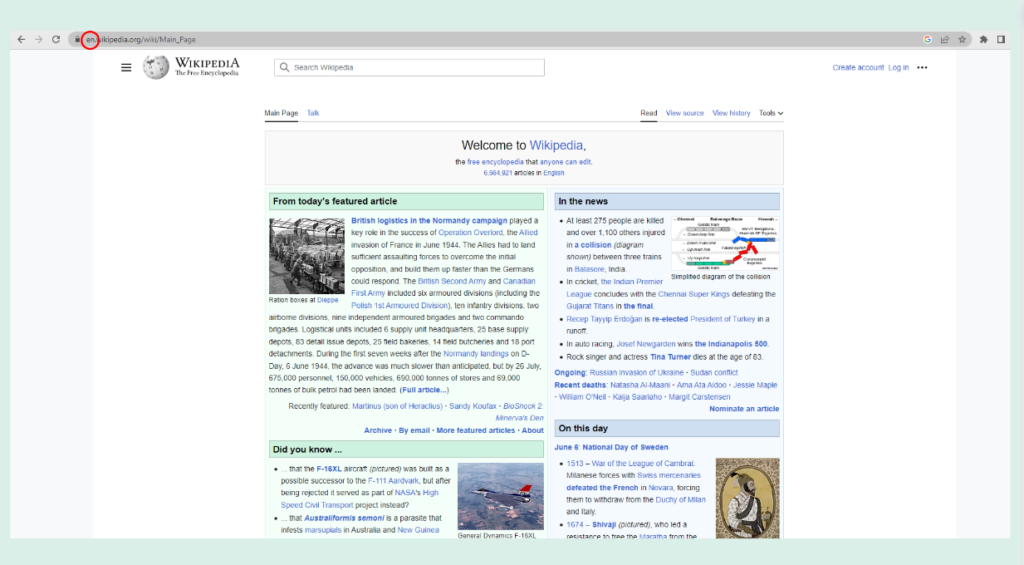
In the example provided by Wikipedia, they employ subdomains to distinguish between languages on their main site.
Subdomains serve various purposes, all aimed at enhancing the user experience by making it more convenient and faster.
Create a subdomain in 3 easy steps
Creating a subdomain is a straightforward process that can be done through your web hosting provider.
Let’s take HostGator as an example to understand the steps involved.
#Step 1: Login to Your Account
Start by logging in to your account’s backend or control panel. Scroll down until you locate the section dedicated to managing multiple domains.
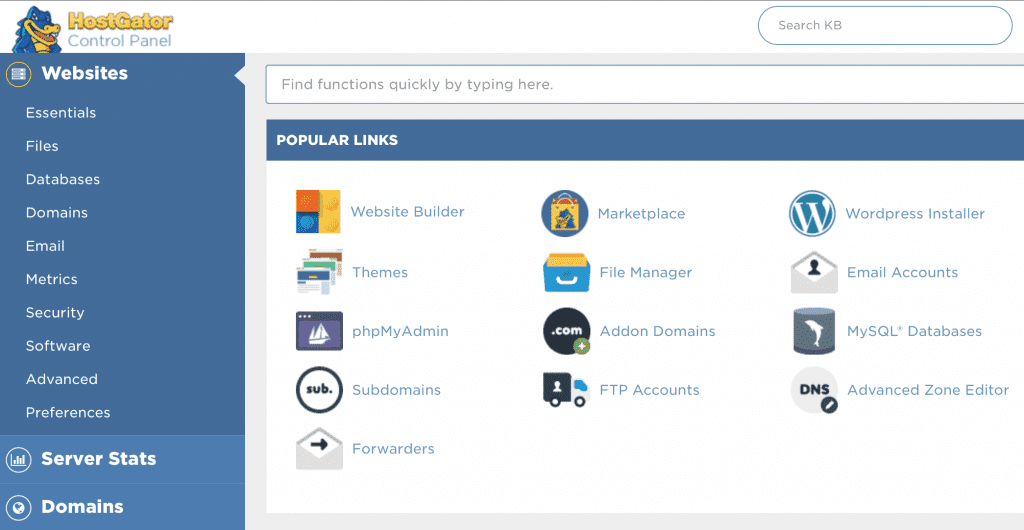
#Step 2: Create a Subdomain
In this section, you will need to enter the desired name for your subdomain and specify the domain to which you want to attach it. To illustrate this process, let’s use an example of a blogging site.
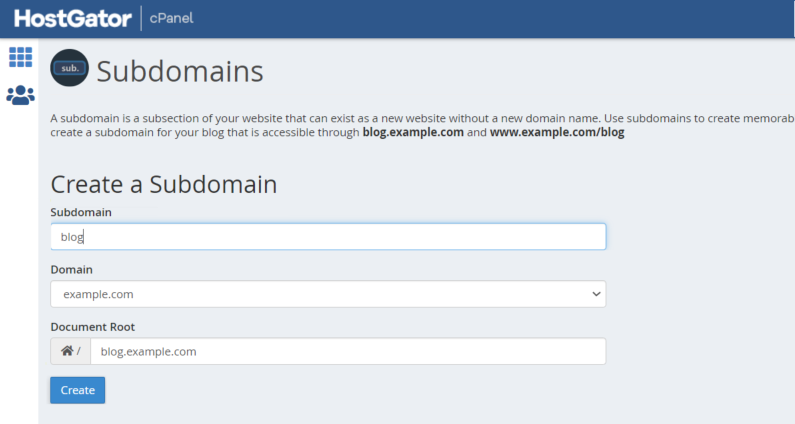
#Step3: Update DNS Records
After creating the subdomain, the next step is to update the domain name system (DNS) records.
This involves adding a new DNS record for the subdomain. Keep in mind that it may take some time, typically between one to 24 hours, for the changes to propagate and be fully implemented on your site.
Therefore, it’s important to be patient and avoid expecting immediate results.
The difference between subdomain vs subdirectory
Many people often confuse subdomains with subdirectories, so let’s clarify their dissimilarities.
Consider the following examples:
- Subdomain: blog.example.com
- Subdirectory: example.com/blog
With a subdirectory, the addition to the URL remains part of the main domain. It represents a section within the website as a whole and doesn’t signal to Google that it’s a separate entity.
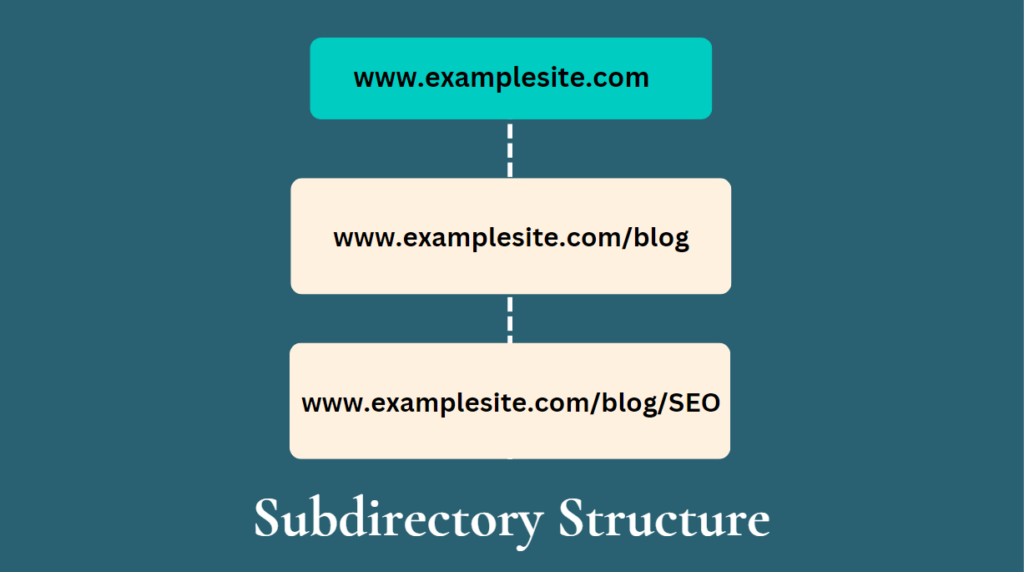
On the other hand, subdomains aim to function independently, treating themselves as separate sites in Google’s eyes.
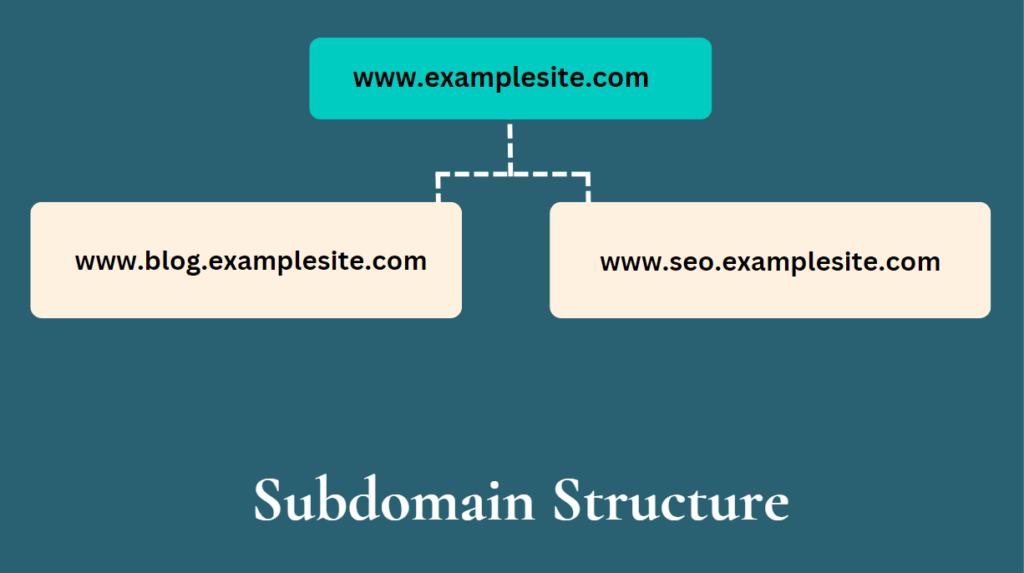
It’s important to note that subdirectories come after the main domain, while subdomains come before it.
Subdomain or Subdirectory: Which option is better for SEO?
The key point to understand is that Google treats a subdomain as an separate entity.
This means that any actions you take within the subdomain won’t impact the overall domain rating of your primary domain. All the links and content in the subdomain are not factored into the main site’s reputation.
This can be either advantageous and the same way disadvantageous depending on your goals.
If the subdomain is a separate website, serving a completely different purpose from the parent domain and might potentially harm its reputation, then having a separate subdomain can be beneficial.
However, if the subdomain is closely related to the parent domain and you want to consolidate all links and content under the main site, then using a subdomain could be detrimental.
In most cases, the SEO benefits of choosing between subdomains and subdirectories is minimal.
It’s often more worthwhile to focus on other important aspects such as conducting content audits and optimizing for mobile devices.
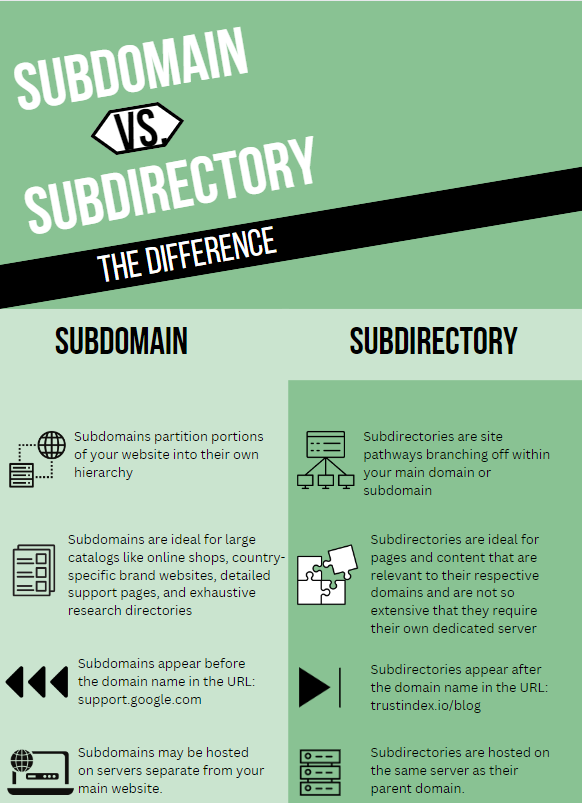
When to use subdomains on your website
Now that you have an understanding of the differences between subdomains and subdirectories, let’s explore when it’s appropriate to use one over the other.
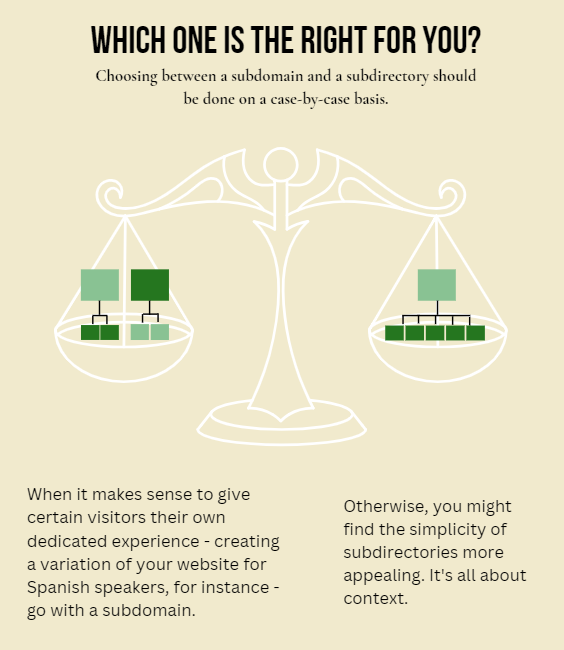
1.) Detach from your main domain
There are situations where you want to create content or perform activities on your website, but you prefer to keep them separate from your main page.
For instance, adding an online store to your website is a perfect example.

In the case of Nascar, they use a subdomain for their eCommerce store, which is an entirely different website for digital marketing from the main Nascar.com website. This decision aligns with the respective purposes of each URL.
Nascar.com aims to provide time-sensitive news about races and drivers, while the store targets individuals interested in purchasing Nascar merchandise and apparel.
Although these two sections are related with the same domain name, each URL serves a different purpose and should be treated independently from an SEO perspective. Therefore it is not just a formality.
2.) Organization for better SEO
Google emphasizes the significance of on-page experience, and it’s something that users also value.
If your website is disorganized and challenging to navigate, people will quickly abandon it. It’s as straightforward as that.
Subdomains come to the rescue by allowing you to organize your website more efficiently. They help reduce the overload of information on a single page.
Nobody enjoys sifting through numerous pages to find a simple answer they’re seeking. As a website owner, it’s your responsibility to offer your customers a top-notch user experience.
Both subdomains and subdirectories can assist in achieving this goal.
Divide different languages
If you run multiple businesses across various countries, it can be beneficial to employ subdomains to represent each language.
As mentioned earlier with the Wikipedia example, many international brands adopt this approach to enhance the organization of their websites.
By using subdomains, they enable Google to accurately target the appropriate language for their audience.
Cases when you should not use a subdomain
If SEO is your main strategy for driving traffic to your website, it might be wise to avoid using subdomains.
Maintaining brand cohesiveness across all aspects of the same website is important.
There’s no need to restrict keyword-rich content solely to certain sections like sales and product pages.
Google treats subdomains as separate entities from your blog, Google search console won’t pass on the link juice and keyword relevance to your main site.
It’s important to note that Google won’t penalize you for using subdomains, but it won’t offer any direct benefits either.
Instead, I believe the focus should be on creating high-quality and relevant content to enhance your website’s SEO.
You can still organize your site effectively without relying on subdomains, ensuring a positive user experience for all visitors.
Benefits of subdomains for SEO
While we’ve emphasized that subdomains shouldn’t be the main focus for SEO, it’s important to explore their potential benefits. Here are some reasons why subdomains can actually be advantageous for your website.
1.) Enhance the on-site experience
According to a significant user experience study conducted by Amazon Web Services, 88 percent of online shoppers would not return to a site if they had a bad experience.
It’s not surprising considering the abundance of alternatives available.
Just as in a physical store, if you couldn’t find what you were looking for and received no assistance, you wouldn’t likely return. The same applies to the online realm.
2.) Boost your domain authority
Domain authority is a rating that reflects how trustworthy and relevant your website is to searchers.
The higher the score, the better. Initially, when a site is created, it is assigned a score of 1.
By consistently publishing high-quality content, attracting traffic, and keeping visitors engaged, your domain authority will increase.
Utilizing subdomains can contribute to this by strategically linking between different domains. For instance, you can create blog content with links to products in your store.
This kind of interlinking, when done in moderation, can have a positive impact on SEO results.
3.) Improve content organization
We’ve emphasized the importance of user experience and content organization.
Well-organized content not only makes it easier for people to navigate your site but also facilitates Google’s crawling process.
This allows Google to locate the keywords you’re targeting more efficiently. When Google can easily navigate your site, users can do the same.
4.) Relevant keywords for Google web search
While keywords in URLs have minimal influence on rankings or user experience, using keywords as an overarching subdomain can potentially benefit your SEO efforts.
This approach aids to organize content and helps Google quickly understand the topic of that specific section of your site.
Although the impact may not be significant, it can contribute to improved crawling and categorization.
Downsides of using a subdomain for SEO
Let’s discuss some of the ways subdomains support negative impacts on your site.
1.) Dilution of SEO efforts
Imagine you have two buckets of water, and you can only drink from one bucket when it’s completely filled.
If you’re desperately thirsty, would you evenly fill both buckets or focus on filling one?
Having unnecessary subdomains divides your search engine optimization efforts between two sites instead of focusing on a single domain. This means you may need to invest twice the effort in generating links and creating content to achieve the same results that could be achieved by focusing on one domain.
If you have a blog post on a subdomain, the inbound links it receives will benefit only the blog subdomain, leaving your main URL with fewer benefits.
2.) Limited internal linking benefits
Links from a subdomain to the main pages of your site are considered external links.
However, internal linking is a crucial ranking factor in SEO. When you link from a subdomain to a main page, it doesn’t count as an internal link.
This can potentially weaken your site’s link authority in the eyes of Google.
3.) Complexity for Google to crawl the root domain
While initially, Google’s algorithm needs to learn to crawl subdomains separately, this separation doesn’t last forever.
Since subdomains are treated as separate entities, you’ll need to verify and track them individually in tools like Search Console and Analytics.
This additional complexity can make it more challenging for search engine crawlers to crawl your site effectively, although it may result in a better overall experience once properly set up.
Should you use a subdomain?
Now that you understand what a subdomain is, you may be wondering whether it’s the right choice for your site.
While subdomains can be useful in specific situations, I would advise proceeding with caution and only using them if necessary. When it comes to SEO ranking factors, subdomains are generally not at the top of the list.
Instead, I recommend you organize content on your site effectively. Take the time to develop a content calendar and consistently create high-quality content.
Work on improving your on-site SEO by optimizing page titles, meta descriptions, headings, and internal linking.
By prioritizing these aspects, you can enhance the overall user experience and increase the chances of ranking well in search engine results.
So, while subdomains may have their place, it’s often more beneficial to concentrate on these fundamental SEO practices to drive organic traffic to your site.
Frequently Asked Questions
Subdomains are treated as separate entities by Google for SEO. They have their own ranking and authority, independent of the main domain. SEO strategies for subdomains need to be done separately.
There is no definitive answer as to which is better for SEO. It depends on the specific circumstances and goals of your website.
